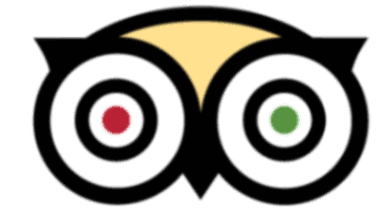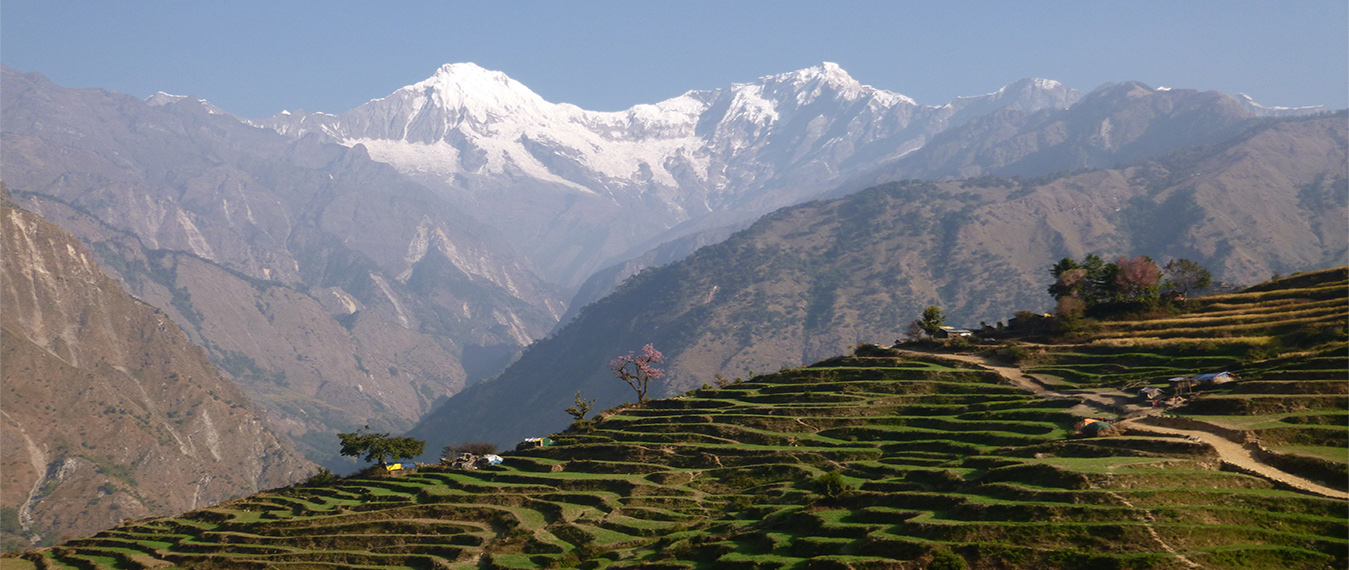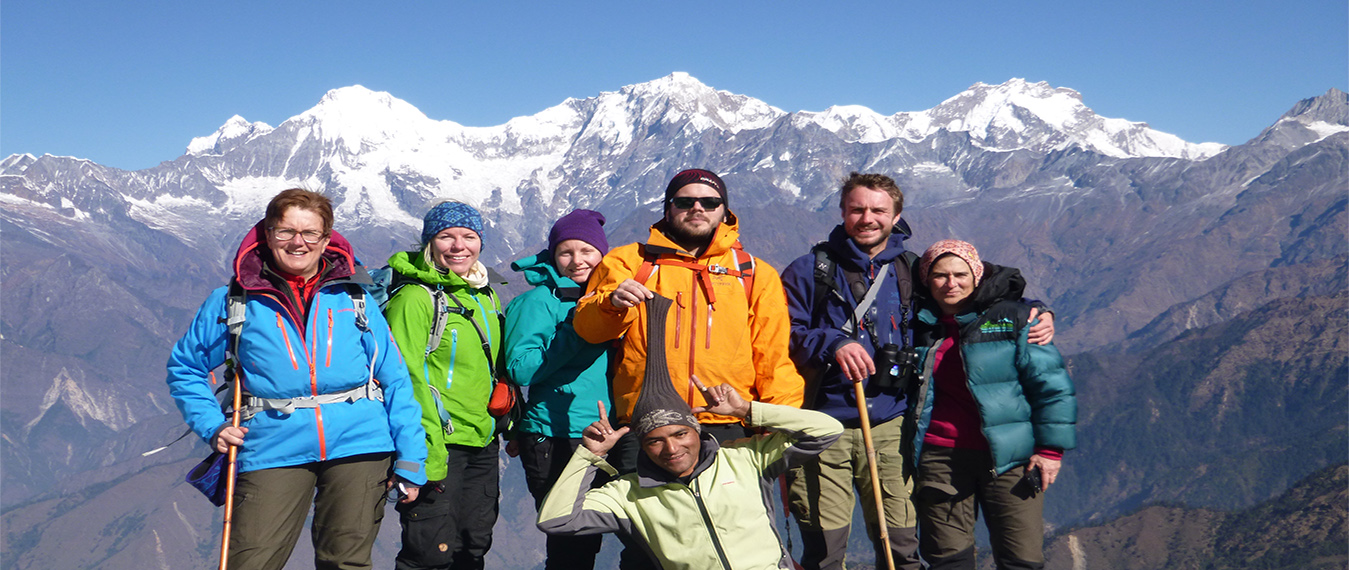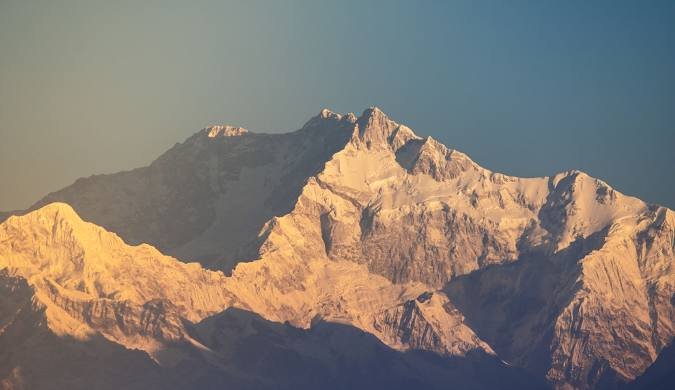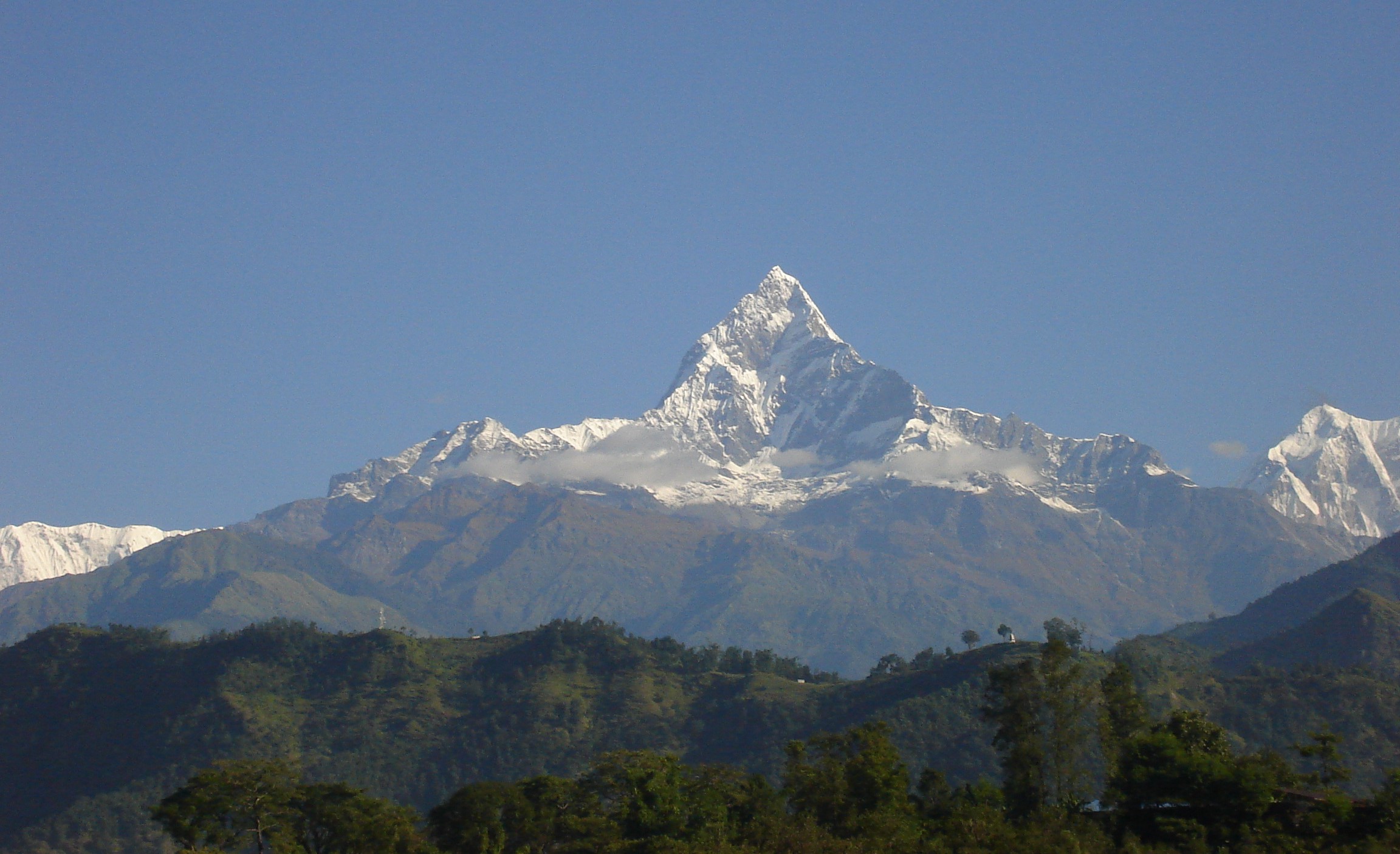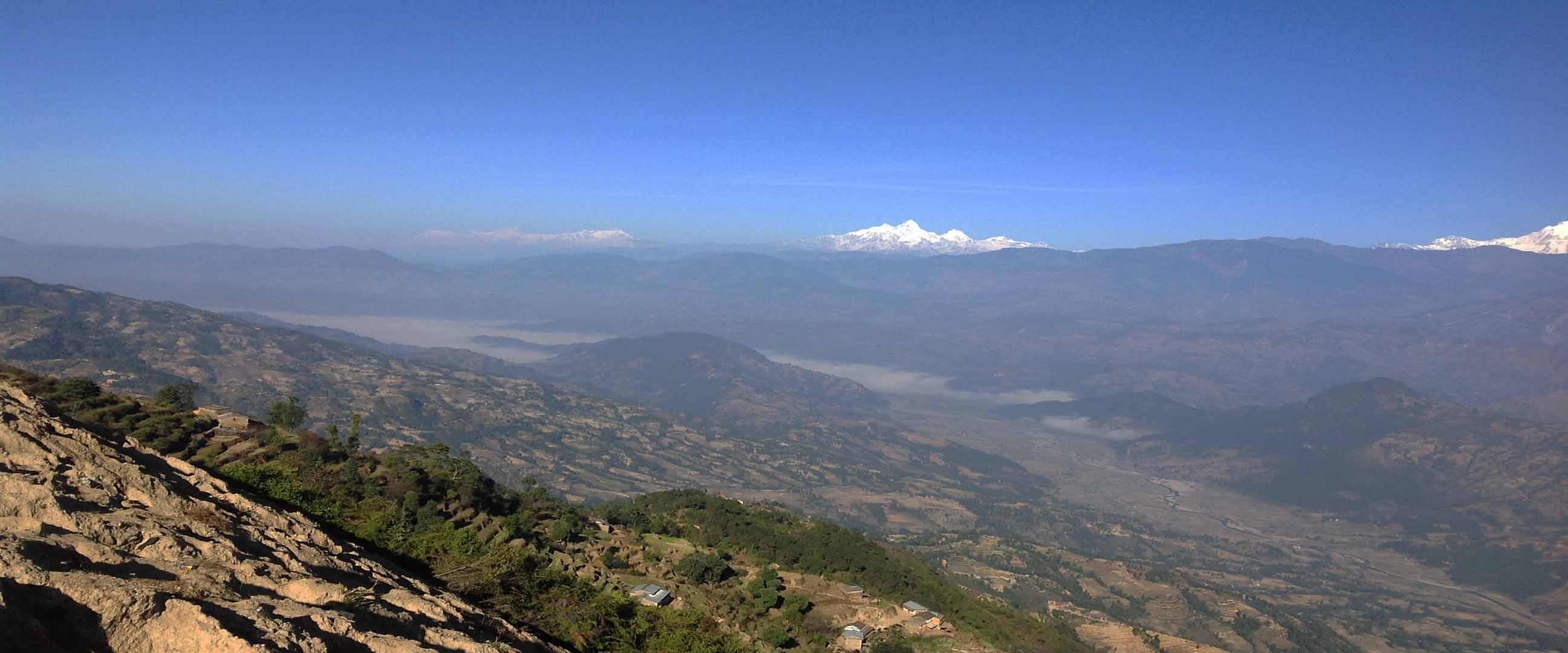- Home
-
Nepal
-
Trekking
- Dhampus trek
- Jomsom Muktinath Trek
- Annapurna Base Camp Trekking (Sanctuary)
- Annapurna Circuit(Round) Trekking
- Mardi Himal Trekking
- Ghorepani Cleaning Trek
- Annapurna Panorama Trek
- Annapurna Culture Trek
- Everest Base Camp Trek
- Everest Panorama Trek
- Khopra Trek
- Mohare Danda Trek
- Ganesh Himal Trekking
- Ganesh Himal Medical Trek
- Langtang Valley Trek
- Langtang Gosainkund Trek
- Ganja La Pass Trekking
- Ruby Valley Pangsang Pass Trek
- Langtang Gosainkund Helambu Trek
- Tamang Heritage Trek
- Panch Pokhari Trek
- Upper Mustang Trek
- Everest High Pass Trek
- Gokyo Valley Trek
- Gokyo Chola Pass Trek
- Salleri to Everest Base Camp Trekking
- Pikey Peak Trek
- Tsum Valley Trek
- Manaslu Circuit Trek
- Lower Dolpo Trek
- Makalu Base Camp Trek
- Ghorepani Poon Hill Trek
- Helambu Trek
- Jyamrung Trek
- Chepang Indigenous Trek
- Dhampus Sarangkot Trek
- Ghandruk Trek
- Surya Chaur Chisapani Trekking
- Yoga Soft Trek
- Indigenous Trek
- Nepal Social Treks
- Yoga Shamanism Trek
- Chisapani Nagarkot Dhulikhel Trek
- Kathmandu Valley Trek
- Khaptad National Park
- Jiri to EBC Trek
- Nomad Community Trek
- Annapurna Luxury Trek
- Tilman Pass Trek
- Helambu – Ama Yangri Trek
- Kangchenjunga North Base Camp Trek
- Peak Climbing
- Chulu West Peak Climbing
- Chulu Far East Climbing
- Island peak via Gokyo-Chola-EBC
- Island Peak Direct Route
- Lobuche Peak Climbing
- Mera and Island Peak via Apulapcha Pass and EBC
- Mera Peak Direct Route
- Mera Peak Climbing
- Naya Kangi Peak Climbing
- Paldor Peak Climbing
- Pisang Peak Climbing
- Tent Peak Climbing
- Yala Peak Climbing
- Pachermo Peak via Tsho Rolpa Lake
- Lobuche Peak via Gokyo Chola Pass EBC
- Rafting and Kayaking
- Wildlife Safari
- Adventurous Trip
- Mountain Biking
- Hiking
- Tours
- Day Tours
- Expedition
- Ganesh Himal-I Expedition
- Ganesh Himal -IV Expedition
- Makalu Expedition
- Annapurna Expedition
- Ganesh Himal -V Expedition
- Dhaulagiri Expedition
- Ama Dablam Expedition
- Cho Oyu Expedition
- Everest Expedition from Tibet Side
- Everest Expedition
- Kanchenjunga Expedition
- Lhotse Expedition
- Manaslu Expedition
- Pumori Expedition
- Annapurna I Climbing
- Ganesh Himal Climbing
- Himlung Himal Climbing
- Tibet
- Tours
-
Bhutan
-
Tours
- Trekking & Hiking
- India
-
Tours
- Trekking and Hiking
- Multi Country
-
Nepal Tibet Bhutan Trekking
- Nepal Bhutan Tour
- Nepal Bhutan Trek
Ruby Valley Pangsang Pass Trek
Key Points
- Destination: Nepal
- Activity: Trekking
- Duration: 13 Days
- Max Altitude: 4200 m
- Group -Size: 2-15 pax
- Fitness Level: Moderate
Trip Overview
Ruby Valley Pangsang Pass Trek is one of the most enriched routes for trekking in the Nepal Himalayas, with rich flora, fauna, and natural heritage.
The trek is best designed to show you the grandeur and beauty of Ganesh Himal from close up, and it is a very newly opened/named trekking destination. In 2011 and 2012, the Trekking Agencies Association of Nepal conducted a series of surveys and named the Ruby Valley Trek as the rich treasure of Ruby, Quartz, and Nilam found in the region.
Very small numbers of trekkers have visited this pristine region, which offers experience of rural life, a beautiful view of the Himalayan peaks of the Ganesh Himal range, a walk in the deep forest of pine and rhododendron, and beautiful farm terraces.
During the trek, you closely view the mountain peaks of Ganesh Himal, including Ganesh I, or Yangra Peak (7,422 m/24,350 ft), Ganesh II (7118 m/23,353 ft), Ganesh III (7,043 m/23,107 ft), and Ganesh IV, or Pabil Peak (7,104 m/23,307 ft). The Ganesh Himal range is separated by the Trishili River with the Langtang massif and the Budhi Gandaki River with the Mansiri and Shringi ranges.
This trip can be organized in camping mode; there is no tea house accommodation available at every stop, so we carry all our kitchen utensils, cook by our expert cook, and sleep in tented accommodation as far as local tea houses or homestays are not available. This is, for sure, a real adventure and a natural way of experiencing rural Nepal.
Itenerary
Arrival in Kathmandu. Meet with our friendly representative at the arrival terminal of only International airport. And, then you will be transferred to your hotel. You check-in at your Hotel and then after short rest you can go to explore market area of Thamel – where you can eat your supper, change money, buy some stuffs from supermarket, or buy trekking gears – if you need to do. Later we take you to our office for the trip briefing. Overnight at your hotel. Delay of any kind will postpone the events for next day according to feasibility.
You start the day with delicious breakfast served at your Hotel. The sightseeing involves tour of two religious and cultural sites of Pashupatinath temple and Boudhanath stupa. Pashupatinath Temple: It is one of the most celebrated Hindu temples in South-Asia. The temple is devoted to Lord Shiva. This place is a UNESCO world cultural heritage site. The Bagmati river flowing besides the temple is religiously and spiritually significant for Hindus where cremation of dead body takes place. Pashupatinath temple holds the most of prominence during Shivaratri – Shiva’s birthday and thousands of pilgrims gather in the night to celebrate the day. Boudhanath Stupa: It is one of the biggest Stupas in terms of size and height in Nepal and located in east of Kathmandu in the ancient trade route between India-Nepal and Tibet. The site is peaceful and culturally filled with intermixed influence of Tibetan and Sherpa roots. Stupa built in the trading route between Kathmandu and Tibet has four pairs of eyes directed towards all four directions. It is believed to be influenced by Mahayana Buddhist philosophy. After short tour of city we return to hotel and prepare for the trek. Overnight will be spent at hotel.You start the day with a drive to Syabru Besi – a small town in the confluence bank of river Bhotekoshi and Langtang Khole. The day starts early in the morning. You pass various towns such as Trishuli Bazar, Betrawati – a town famous in Nepali history for the peace treaty between Gorkha kingdom and China – and Dhunche. The drive is scenic with various different landscapes. The river bed of Trishuli with rice field, terraced farm field of the hills, dotted villages in the high hills attracts you. You enter into Langtang National Park near Dhunche and reach the Syabru Besi – a gateway of Langtang classic You continue drive Gatlang – a huge Tamang ethnic settlement in the lap of the Himalaya with unique culture, customs, and lifestyle. during the full moon day in July-August (Janaipurnima). Stay overnight in community lodge.After breakfast, marvelous day begins with a ascend in the pine and rhododendron forest. there is a small lake named Parvati Kund which is visited by pilgrims . You stop at Yuri Kharka for lunch and then continue to Khurphu Bhanjyang first and then down to the Somdang River - border between Rasuwa and Dhading districts. Somdang is popular for the mining of zinc compound, tin, and others which is no longer functioning. The hike passes through a scenic valley featuring the 200 m Chukarma Waterfall. Arrive Somdang and stay overnight at lodge or Camp.Begin the day with ascend to Pangsang pass , we start early morning to enjoy the himalayan range with sunrise view. a breathtaking viewpoint situated in the southwest of Somdang village with a broad panorama of the surrounding Himalayan peaks and terrain. To the straight north are the soaring peaks of Manaslu, and the Ganesh Himal Range. You are now standing at large meadow with a sensational scenery surrounded. From Pangsang you continue towards Sing la pass, and reach Singla Kharka for the overnight stay. Today is hardest day of the trek because of you are walking high pass.In the early morning you walk the same way back to the Sing La top for the magnificent Mountain View and sunrise. After this return back to the Kharka, Enjoy breakfast and then walk to Chalise./Sertung village is inhabited by ethnic Gurung, Ghale, and Kami people. They have unique culture, customs, craftsmanship, and traditional rich dance forms including Ghatu, Dohori and others. Overnight at the homestay or Camp.
In the early morning hike to the view point “Mugu Danda”. You will have a magnificent view of Ganesh Himal range, Paldor peak, many villages in the lower altitudes, and beautiful surrounding hills. On the way back, you can visit Phyanchyat Gumpa and Tamang village- Sertung. Have a breakfast and then go for a visit to natural hot spring – Tatopani – with pack lunch. In the evening, enjoy the cultural program offered by a group of local people to entertain you (your group size and availability of cultural group matters). You may donate some money to the group so they utilize the amount to community welfare. Stay overnight at the home stay or camp.Today you walk to Ruby Khani( stones mines) and then to Ganeshkunda. Ganesh Kunda is one of the three lakes in the area and sacred lake of the region. In this lake, in September hundreds of Jhakri (shamans) along with local inhabitants visit this lake and celebrate the festival. In this area Ruby mines can be seen. Ruby is a pink blood-red colored gem stone available in this region of the Himalayas. Overnight stay in the tented camp.Enjoy your breakfast and then walk all the way down to Lapa Gaon. You trek all the way down to Ankhu Khola, cross the suspension bridge and finally arrive Lapa gaon. It is one of the biggest villages in this region and has big settlements of Tamang community who has their distinct language, culture, and customs. You may get an opportunity to enjoy their cultural show depends upon availability.Overnight in the tented camp.Today you walk to Awai Borang village from Lapa Gaon. First you walk down to Ankhu Khola and then continue the walk to Awai village – a small village near main Borang village. We have support the children going school and we have built the school here. Walk around the village and check our social project.Overnight in the tented camp.You drive back from the mountain to Kathmandu today. The drive is adventurous, and scenic in the mountain landscape. First you drive to Dhading besi – the administrative capital town of Dhading district – and enjoy the lunch here. Continue to Kathmandu after lunch. Arrive Kathmandu and transfer to your Hotel.Kathmandu city comes with a century long history of markets, trading spots, various arts, buildings with architectural and cultural affluence. On your last day, you will be exploring the local market of Asan, Indrachowk and Newroad, only to discover the historic and cultural identity of this beautiful city. You will then reach to Kathmandu Durbar Square; centre to accumulate Kathmandu’s architectural prominence. Here, you will experience an unique culture of “living goddess”, visiting her temple could make your trip informative and exhilarating given the cultural differences. After this eventful day, you will spend your night at hotel and prepare for the departure next day.We will drop you to airport and bid our adieu. You will be taken to airport 3 hrs before the scheduled flight.What is Included?
- Airport pick-up & drop-off with representative.
- Nepal’s 3-star-level hotel accommodation with breakfast in Kathmandu.
- Experience Trekking Guide and Assistance Guide.
- equipments/cooking utensils.
- All Staff ( cook, Kitchen staff, Sherpa, porters, and other necessary staff for the tented camping trek)
- All Camping Gear (Two men tents, dining tent, kitchen tent, toilet tent, table, chair down jacket, sleeping bag, matrices, torch light, water bottle, etc)
- All Cooking gear
- Hot & cold drinks. (Tea, coffee, hot milk, hot chocolate, & juice.).
- All meals in the trek (Breakfast, Lunch & Dinner.)
- Accommodation in tents, camps, lodges, or Homestays as available/required during the trekking
- 4-wheel jeep (Kathmandu - Gatlang and Borang - Kathmandu)
- TIMS (Trekkers Information Management System)
- Langtang National Park permit
- All food, drinks, lodge, salary, insurance, medical equipment, land transport, etc. for trekking staff.
- Down jacket, Down sleeping bag, and Duffel bag.
- Sightseeing with guide, transport, and entry permits in Kathmandu.
- All taxes and services are charged.
What is Excluded?
- Any bar bills (alcoholic drinks, mineral water, and cold drinks),
- cigarettes, client’s personal insurance, any kind of unforeseen expenses etc
- Lunch and Dinner in Kathmandu.
- Gratuities to guide, porters and driver (Not mandatory but expected as customary thank you for the service)
- International air ticket and Visa fee
- Travel insurance that must include emergency helicopter evacuation and any sikness.
Equipment Checklist
This list outlines the required things to bring during the trekking tours. There are various selections and brands that you can choose as per your interest. All required trekking equipments can be bought or even hired easily at a reasonable price in Kathmandu.
General
- Four seasons Sleeping bag (optional; we can provide one if you need it but is to be returned after the trek)
- Duffel or Rucksack bag & suitcase (optional; we can provide one if you need it but is to be returned after the trek)
- Daypack
- Down Jacket (we can provide one if you need one but is to be returned after the trek)
Upper Body: Head, Ears and Eyes
- Sun hat
- Warm wool or synthetic hat that covers your ears.
- Goggles or sunglasses for sunbeams, dust and wind
- Headlamp
- Some people like ear-muffs; These are optional; a good hat, balaclava, and hooded jacket should really be sufficient, but this is a personal choice for some people.
- A neck warmer is another piece of gear for extra warmth if you feel you will need it (optional).
Hand
- Gloves ( not too warm and not light )
Core Body
- T-shirts
- Shirts
- Fleece jacket or pullover.
- Fleece Wind-Stopper jacket (optional).
- Waterproof (preferably breathable fabric) shell jacket.
- Women sports bras: Synthetic, no cotton!
Lower Body: Legs and Feet
- Nylon hiking shorts are quick-drying, not cotton!
- Underwear: stay away from cotton (4).
- Lightweight long underwear - capilene or other synthetic.
- Softshell pants—synthetic, full zip from top to bottom—are preferable.
- Trekking pants, preferably those that zip on/off at the knees so they double as shorts..
- Cotton pants (loose jeans/khakis).
- All clothing should be kept dry using waterproof stuff sacks or large puncture resistant plastic bags.
- Two pairs of heavy-weight socks to be worn over liner socks are preferable for cold season.
- Two pairs of light-weight socks are a good option for the lower and warmer parts of the trail.
- light- to medium-weight water-proof hiking/trekking boots.
- A pair of light trekking shoes or sneakers. Good for around the camp/lodges and in Kathmandu.
- A pair of sandals (optional).
Medicines and First Aid Kits
Please note that our guide will also carry the first aid kit bag during the trek. However, we still recommend that you bring your personal first aid kit as well.
- Extra Strength Excedrin for altitude related headaches.
- Ibuprofen for general aches and pains.
- Immodium or Pepto bismol capsules for upset stomach or diarrhea.
- Diamox (commonly prescribed as Acetazolamide) 125 or 250mg tablets for altitude sickness. Please discuss with us before starting to take this medicine.
- 1 small personal sized first-aid kit with blister treatments such as mole skin, band-aids, some waterproof tape, anti-infection ointments, etc. Your guides will have more extensive medical gear, but you should have the basics for general use.
Miscellaneous
- Passport and extra passport photos (4 copies).
- Airline ticket (Please make a copy and leave it at our office in KTM just in case if you need to change the date of your ticket).
- Durable wallet / pouch for travel documents, money & passports.
- Lip balm. At least SPF 20, 2 sticks. A string taped to the stick is helpful to hang around your neck and some are now being sold with a cord already attached. It is handy as it prevents you from having to stop and look for it.
- Sunscreen. SPF 40 is recommended and should be relatively new since it loses its' effectiveness over time.
- Pocket knife or small Swiss Army type.
- Water purification Iodine tablets or Polar-pure crystals.
- Toiletry kit. Be sure to include toilet paper stored in a plastic bag, hand wipes, liquid hand sanitizer, towels, soap, etc.
- 2 bandanas.
Optional
- One pair adjustable trekking poles. Although these are listed as optional, they can be of great assistance to people who may think of themselves as generally clumsy or with bad knees, ankles, etc, especially when going downhill
- Favorite snack foods
- Paperback books, cards, and an MP3 player (there are a couple of stops where you could recharge. Avoid players with moving hardware, as it may not function. Remember, keep these items light weight
- Binoculars
- One light weight point and shoot camera or 1 large SLR. Digital cameras are fine, but you must keep the batteries warm when not in use
- Hydration bladder with drinking tube and tube insulator
- A pee bottle for men and pee funnel for women,some swear by them to avoid that chilly late-night trip
- One small stainless steel thermos
All garments should be kept dry using waterproof stuff sacks or large puncture resistant plastic bags.
Trip Reviews
Write Your Review
- Best Price Guarantee
- Hassle-Free Booking
- No Booking or Credit Card Fees
- Team of highly experienced Experts
- Your Happiness Guaranteed
Quick Inquiry
We Offer Group Discount
Write Us- 1 Pax US$ 1550
- 2 Paxes US$ 1350
- 3 Paxes US$ 1320
- 4 - 6 Paxes US$ 1290
- 7 - 12 Paxes US$ 1250
- 13 - 18 Paxes US$ 1210
- 19 - 24 Paxes US$ 1175
- 25 - 30 Paxes US$ 1150
- Best Price Guarantee
- Hassle-Free Booking
- No Booking or Credit Card Fees
- Team of highly experienced Experts
- Your Happiness Guaranteed
Quick Inquiry
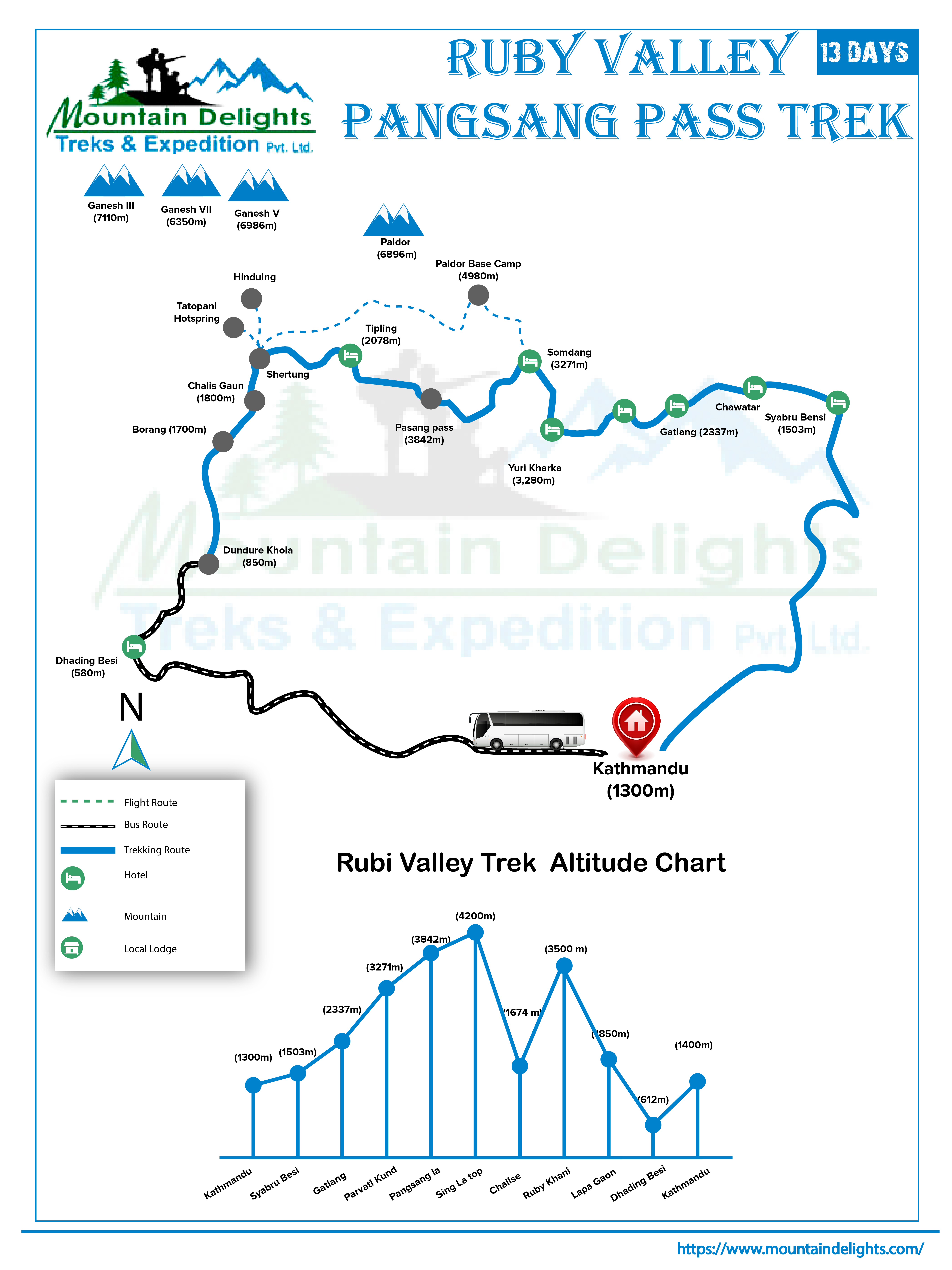 ;
;Related Packages
Are you looking forward to extend your travel business in nepal?
Partner With UsTOP
- Nepal Bhutan Tour
-
Tours
-
Trekking

